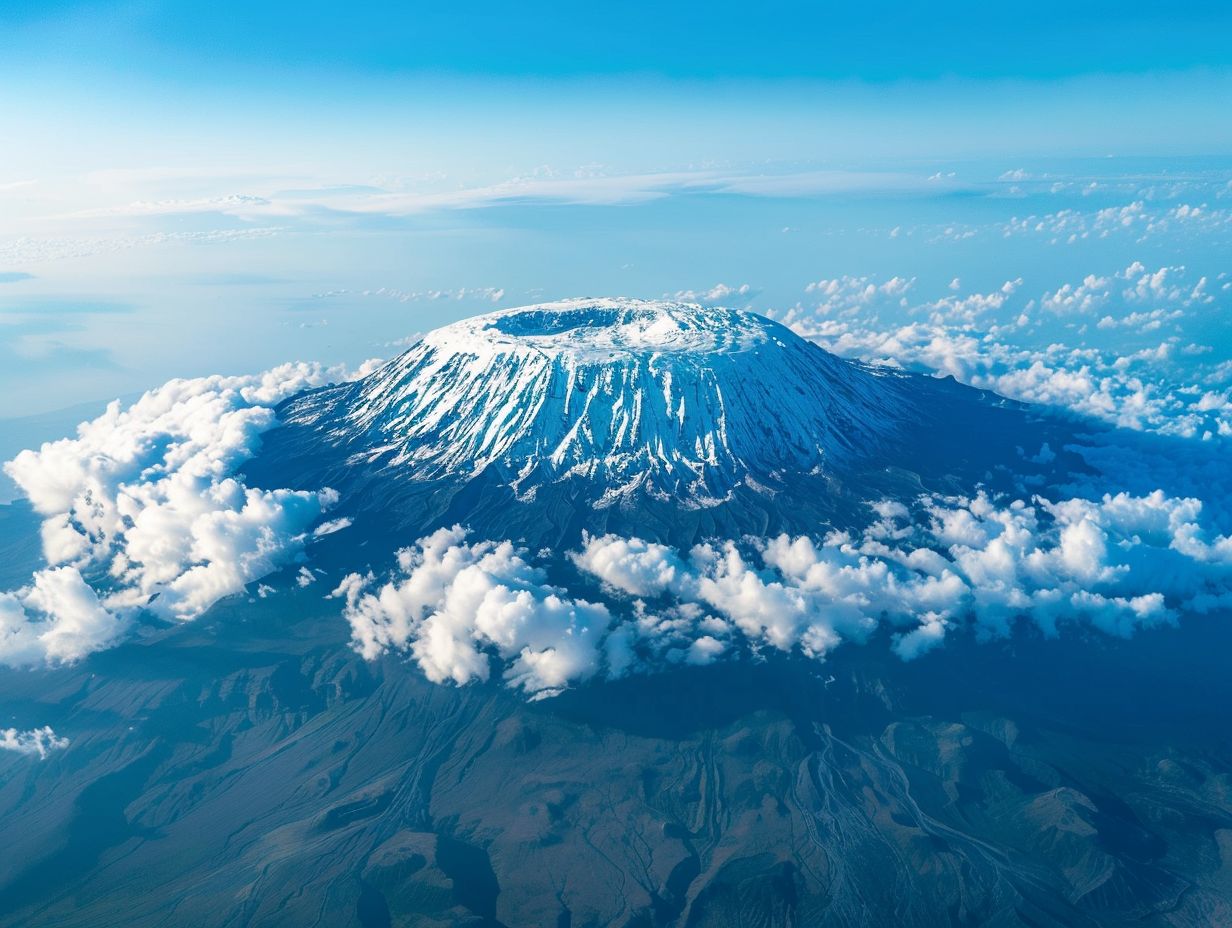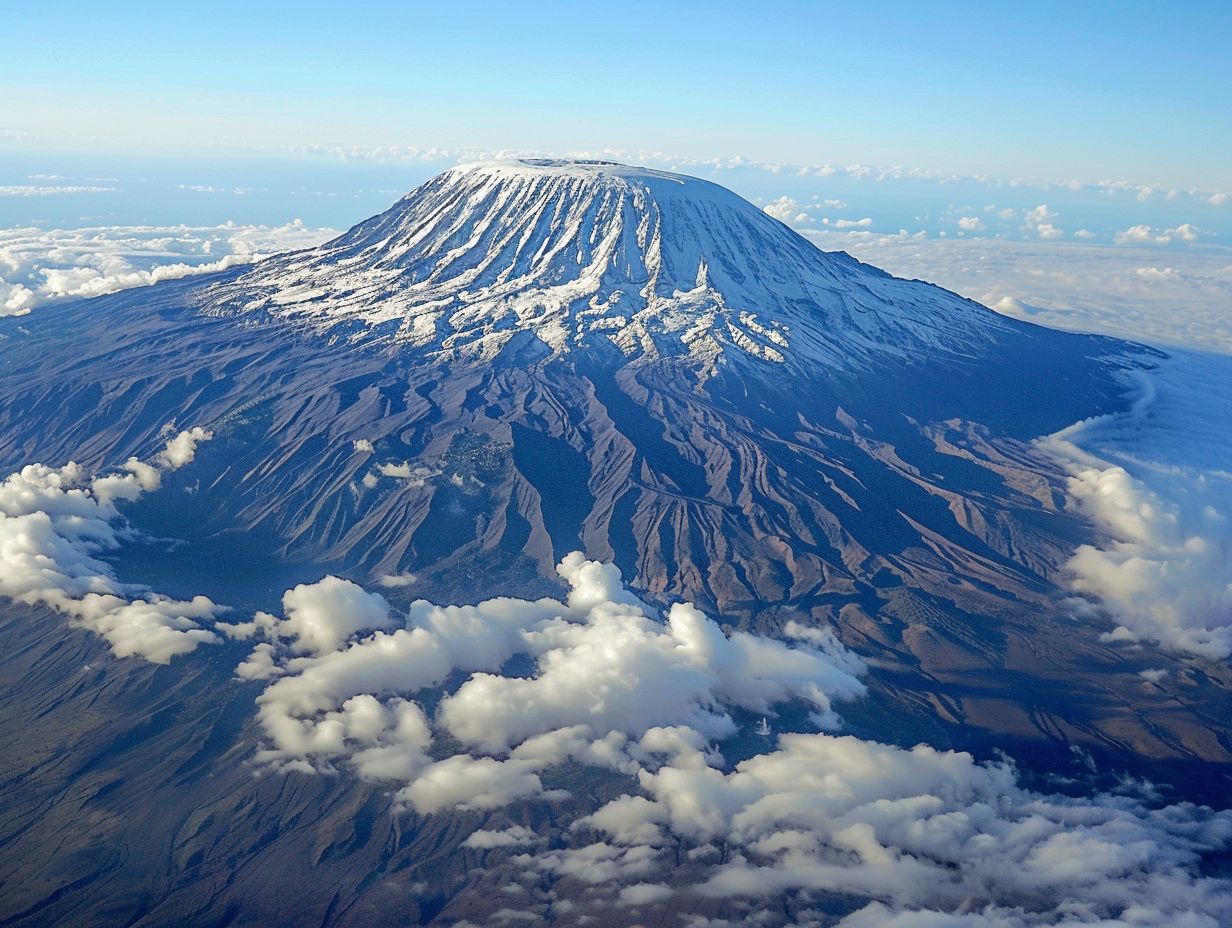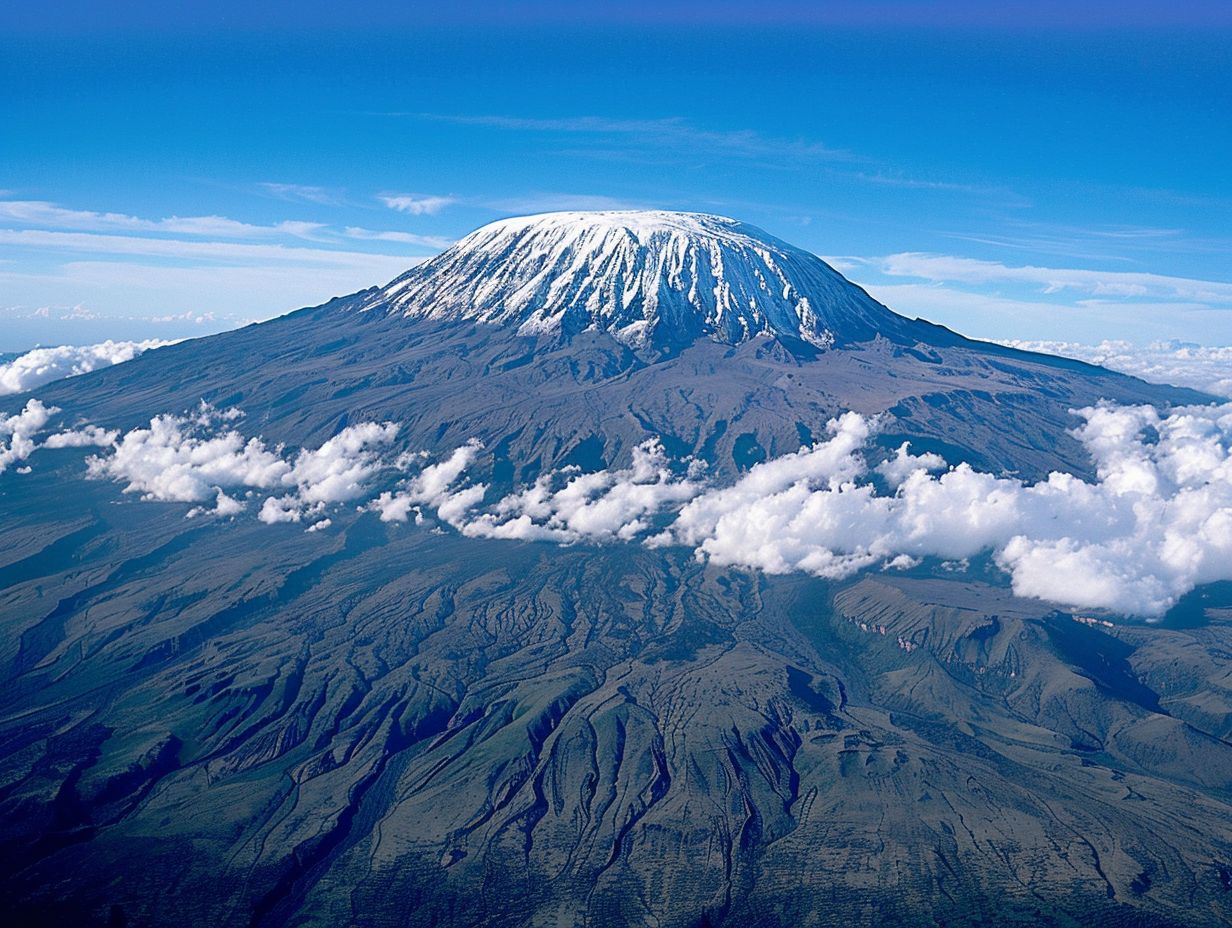
Are There Dead Bodies On Kilimanjaro?
Mount Kilimanjaro, the highest peak in Africa, has a rich history of exploration and myths.
From early expeditions to the development of tourism, the mountain has captivated adventurers for centuries.
But alongside these tales lies a morbid question – are there really dead bodies on Kilimanjaro?
The frozen remains of a German missionary, a Tanzanian porter, and a Japanese climber have sparked controversy and raised concerns among climbers.
What precautions should climbers take when ascending this majestic mountain? Let’s explore the mysteries and dangers of Mount Kilimanjaro.
Key Takeaways:

- There is evidence of frozen bodies on Mount Kilimanjaro, including a German missionary, a Tanzanian porter, and a Japanese climber.
- These bodies are a reminder of the dangers of climbing Kilimanjaro and the importance of proper precautions, such as acclimatization and hiring experienced guides.
- The legends and history surrounding Kilimanjaro add to its allure, but climbers should always be aware of the potential risks and respect the mountain’s history and culture.
History of Mount Kilimanjaro:
Mount Kilimanjaro, located in Tanzania, has a rich history of exploration and conquest by climbers seeking to summit its highest peak. Over the years, the mountain has attracted adventurers from around the world, each facing the challenges of high altitude and unpredictable weather conditions.
Exploration of Kilimanjaro dates back to the late 19th century when German geologist Hans Meyer and Austrian climber Ludwig Purtscheller reached the summit in 1889. This marked a significant milestone in the history of Mount Kilimanjaro as the first recorded successful ascent.
The development of climbing routes progressed with the establishment of the Marangu route, known as the ‘Tourist Route’, due to its facilities, a century later. The Machame, Lemosho, and Rongai routes have since gained popularity for their scenic views, varied terrains, and higher success rates.
Climbers face altitude-related sickness, notably acute mountain sickness, as they ascend the mountain. Safety measures like gradual acclimatization, adequate hydration, and recognizing symptoms of altitude sickness are crucial to a successful climb.
-
Early Exploration:
The early exploration of Mount Kilimanjaro dates back to the 19th century when adventurers began to discover the challenges and allure of Africa’s highest peak. Climbers faced unknown risks at high altitudes, navigating treacherous mountain routes in pursuit of conquering the majestic summit.
Among the pioneering figures in Kilimanjaro’s exploration was Hans Meyer, a German geologist who successfully summited the peak in 1889. Meyer’s detailed accounts of the mountain’s glaciers and terrain provided valuable insights for future climbers.
The indigenous Chagga people had long revered the mountain but were shrouded in mystery to outsiders. Early expeditions also uncovered the diverse flora and fauna inhabiting the mountain’s slopes, further adding to its mystique and scientific value.
-
First Recorded Ascent:
The first recorded ascent of Mount Kilimanjaro took place in (year) by (climber’s name), who successfully reached the summit with the assistance of experienced guides. This historic achievement marked a significant milestone in the mountain’s climbing history, albeit not without its share of challenges and risks.
The journey of (climber’s name) to the summit of Mount Kilimanjaro was filled with immense determination and perseverance. Battling against the unpredictable weather conditions, treacherous terrains, and altitude sickness, (pronoun) demonstrated unparalleled courage throughout the climb.
The role of the experienced guides was invaluable, providing crucial navigation assistance, local knowledge, and safety measures to ensure the success of the expedition. Their expertise and guidance played a pivotal role in overcoming obstacles and ensuring the safety of the entire team.
-
Development of Tourism:
The development of tourism on Mount Kilimanjaro accelerated as more climbers sought to conquer its peaks and experience the breathtaking views from its summit. With the establishment of various climbing routes and improved mountain conditions, the mountain became a popular destination for adventurers and nature enthusiasts alike.
This surge in interest has led to a significant impact on the local economy, with the emergence of tour operators, lodges, and other services catering to the needs of visitors. Local communities have also benefited from employment opportunities in the tourism sector, providing a source of income that has helped improve living standards.
Efforts have been made to ensure sustainable tourism practices on the mountain, including waste management strategies and conservation initiatives to protect the fragile ecosystem.
The diverse range of climbing routes, such as the Marangu, Machame, and Lemosho routes, offers different experiences and challenges for climbers of varying skill levels, contributing to the appeal of Mount Kilimanjaro as a must-visit destination for outdoor enthusiasts worldwide.
Myths and Legends Surrounding Mount Kilimanjaro:
Mount Kilimanjaro is steeped in myths and legends that have been passed down through generations.
Among these tales are the captivating legends of the Chagga People and the mysterious Ice Maiden, adding an air of mystique to the mountain’s already awe-inspiring presence.
According to Chagga folklore, the mountain is believed to be the home of the gods, and its towering peak is seen as a bridge between the earthly realm and the spiritual world. The stories of the Chagga People not only serve as entertainment but also hold deeper cultural significance, shaping their reverence for the mountain and its natural wonders.
The legend of the Ice Maiden, a tragic story of love and sacrifice, further enhances the mountain’s allure. This mysterious figure is said to dwell within the icy depths of Kilimanjaro, captivating the imagination of both locals and visitors alike.
-
The Legend of the Chagga People:

The legend of the Chagga People revolves around their deep connection to Mount Kilimanjaro, depicting a tale of ancestral ties and spiritual reverence for the majestic mountain. According to folklore, the Chagga People believe that the mountain is a sacred entity that watches over their community.
According to their ancient beliefs, Mount Kilimanjaro is not just a physical landform but a living presence, housing spirits that guide and protect the Chagga people. This spiritual connection has shaped their cultural practices, influencing rituals, ceremonies, and everyday life. The mythological narrative weaves a story of respect for nature and the interconnectedness between humans and their environment.
This profound link to Mount Kilimanjaro has also influenced the local community’s environmental conservation efforts. The Chagga People view themselves as stewards of the mountain, safeguarding its natural resources and biodiversity. Their reverence for nature stems from the belief that harming the mountain would bring disharmony to their lives and the land they inhabit.
-
The Legend of the Ice Maiden:
The legend of the Ice Maiden tells the haunting story of a mythical figure who is said to dwell amidst the icy slopes of Mount Kilimanjaro. This enigmatic tale weaves a narrative of mystery and intrigue, captivating the imaginations of those who hear of her icy presence.
According to local folklore, the Ice Maiden is believed to be a powerful and benevolent spirit, closely connected to the elements of snow and ice. Her origins are shrouded in legends passed down through generations, with some tales portraying her as a guardian of the mountain, while others suggest a tragic love story lies behind her eternal ice-bound state.
Her presence on Kilimanjaro is deeply ingrained in the cultural tapestry of the region, with her icy abode serving as both a warning and a beacon of hope for trekkers and locals alike.
The enduring allure of the Ice Maiden’s legend continues to draw in visitors seeking to unravel the mysteries surrounding her icy domain, making her a central figure in the rich storytelling traditions of the area.
Is There Evidence of Dead Bodies on Mount Kilimanjaro?
The question of whether there are dead bodies on Mount Kilimanjaro has long intrigued climbers and adventurers exploring the mountain’s vast terrain. Several documented cases of fatalities and tragic incidents have contributed to the lore surrounding the presence of deceased individuals on the mountain.
One of the most famous cases is that of George Mallory, whose body was discovered on the mountain decades after his disappearance. This discovery reignited the interest and speculation around other climbers who might have met similar fates on Kilimanjaro. The presence of these tragic incidents has undoubtedly cast a shadow over the mountain’s reputation for safety, leading to increased emphasis on safety measures and preparedness among climbers.
-
The Frozen Body of German Missionary:
The discovery of the frozen body of a German missionary on Mount Kilimanjaro added a chilling dimension to the mountain’s history, raising questions about the circumstances of the climber’s demise and the challenges faced by those who brave its unforgiving slopes.
The missionary’s tragic fate sparked a flurry of speculations among climbers and experts, with some suggesting that he might have succumbed to altitude sickness or harsh weather conditions.
The incident serves as a stark reminder of the dangers that come with scaling such extreme altitudes, where the thin air and unpredictable climate can quickly turn a routine expedition into a life-threatening ordeal.
The discovery has reignited discussions about the preservation of the mountain’s fragile ecosystem and the need for stricter safety protocols to prevent future tragedies.
-
The Frozen Body of a Tanzanian Porter:
The preserved remains of a Tanzanian porter found on Mount Kilimanjaro serve as a somber reminder of the risks and dangers faced by those who support climbers in their ascent. The tragic fate of the porter highlights the harsh realities of high-altitude expeditions.
Working as porters, guides, and support staff, these individuals often endure treacherous conditions to ensure the success of climbers reaching the summit. The discovery of the frozen body sheds light on the sacrifices made by these unsung heroes in the mountaineering world. In extreme temperatures and unpredictable weather, every step on the mountain poses a potential threat to their lives.
Incidents like this not only devastate the local communities but also prompt reflection within the climbing community about safety protocols and the importance of proper acclimatization. The chilling image of the porter serves as a poignant reminder of the fragility of human life in such unforgiving environments.
-
The Frozen Body of a Japanese Climber:
The tragic fate of a Japanese climber, whose frozen body was found on Mount Kilimanjaro, underscores the perilous nature of high-altitude mountaineering and the unpredictable challenges that climbers face in their quest to conquer the mountain’s peaks.
This unfortunate incident not only highlights the inherent risks that come with scaling such formidable heights but also sheds light on the demanding nature of rescue operations in remote and harsh mountainous terrain.
High-altitude climbing presents a unique set of challenges, from severe weather conditions to altitude sickness, making it one of the most dangerous forms of adventure sports. The intricate logistics involved in organizing rescue missions at such elevations further complicates the already treacherous situation for both climbers and rescue teams.
-
The Controversy Surrounding the Bodies:

The controversy surrounding the presence of frozen bodies on Mount Kilimanjaro has sparked debates within the climbing community regarding ethical considerations, preservation efforts, and the impact of such incidents on the mountain’s reputation. The preservation of these bodies raises challenging questions about respect for the deceased and the natural environment.
Preserving these bodies on the mountain also brings up concerns related to safety and the psychological impact on future climbers who may encounter such tragic scenes, leading to discussions about the responsibility of authorities in managing these delicate situations.
Conservationists grapple with the balance between respecting the sanctity of the mountain as a natural space and the historical significance of these preserved remains. These contentious issues highlight the intersection of cultural beliefs, environmental ethics, and the practical realities of managing a popular climbing destination like Mount Kilimanjaro.
How Do These Bodies Affect Climbers?
The presence of deceased individuals on Mount Kilimanjaro exerts a profound impact on climbers, serving as reminders of the mountain’s unforgiving nature and the risks associated with high-altitude expeditions. These bodies evoke a sense of mortality and caution among climbers, influencing their approach to the ascent.
Encountering frozen bodies on this majestic peak can trigger a range of complex emotions, from sadness and empathy to fear and introspection. Each preserved figure symbolizes a life lost in pursuit of the summit, a stark testament to the formidable challenges that climbers face.
Coming face to face with mortality in such a tangible form can lead individuals to reevaluate their priorities and reassess the importance of personal safety above all else.
What Precautions Should Climbers Take on Mount Kilimanjaro?

Climbers embarking on a journey to summit Mount Kilimanjaro must prioritize safety and preparedness by taking essential precautions to mitigate the risks of altitude sickness, dehydration, and extreme weather conditions. Hiring experienced guides and equipping oneself with proper gear are crucial steps in ensuring a safe and successful ascent.
Acclimatization plays a vital role in adjusting the body to the decreasing oxygen levels at higher altitudes, reducing the likelihood of altitude sickness. Climbers should pace themselves, ascending gradually to allow their bodies to adapt. Hydration is equally critical; maintaining adequate fluid intake aids in combating altitude effects and ensures overall well-being during the climb.
The right equipment, including sturdy hiking boots, layered clothing to accommodate temperature variations, and high-quality sleeping bags, is essential for comfort and protection on the mountain. Specialized gear, such as crampons and ice axes, may be required for certain routes and seasons.
-
Proper Acclimatization:
Proper acclimatization is essential for climbers on Mount Kilimanjaro to adjust to the high altitudes gradually and reduce the risk of altitude-related illnesses such as Acute Mountain Sickness (AMS). Climbers should follow recommended altitude gain guidelines and listen to their bodies to ensure a safe ascent.
Acclimatization allows the body to adapt to reduced oxygen levels at higher altitudes, helping prevent the potentially dangerous effects of altitude sickness.
Symptoms of AMS include headache, nausea, dizziness, and fatigue, which can hinder a climber’s progression. Climbers can aid the acclimatization process by staying hydrated, maintaining a steady pace, and incorporating rest days into their itinerary. Proper nutrition and adequate sleep play a crucial role in supporting the body’s adjustment to the changing environment on the mountain.
-
Hiring Experienced Guides:
Climbers tackling Mount Kilimanjaro should prioritize safety by engaging the services of experienced guides who possess intimate knowledge of the mountain’s terrain, weather conditions, and safety protocols. Experienced guides play a crucial role in navigating the challenges of high-altitude climbing and ensuring the well-being of climbers.
These guides not only have extensive experience in leading climbs on Kilimanjaro, but they also have specialized training in mountain rescue, emergency first aid, and high-altitude acclimatization techniques.
They act as mentors to climbers, offering guidance, motivation, and reassurance throughout the journey. Their in-depth understanding of the mountain’s routes and ecosystems allows them to make well-informed decisions to mitigate risks and adapt plans according to changing conditions.
-
Proper Equipment and Clothing:
Equipping oneself with proper gear and clothing is vital for climbers embarking on the challenging journey to conquer Mount Kilimanjaro. Adequate preparation, including having the right equipment for varying weather conditions and terrain, is crucial for ensuring comfort, safety, and performance during the ascent.
Climbers scaling Mount Kilimanjaro need to prioritize insulation and protection against the elements – cold, wind, and precipitation. Essential items include high-quality waterproof jackets, insulated layers, thermal gloves, and sturdy hiking boots to combat the freezing temperatures and unpredictable weather.
Bringing along items like a warm beanie, neck gaiter, and thermal socks can make a significant difference in maintaining body heat and preventing frostbite during the climb. Versatile clothing that can be easily layered and removed based on changing conditions is key to adapting to the mountain’s ever-changing environment.
Frequently Asked Questions:
1. Are There Dead Bodies on Kilimanjaro?
A: No, there are no dead bodies on Kilimanjaro. The mountain is a popular destination for hikers and climbers, and all bodies are properly disposed of or brought down from the mountain.
2. What happens to the bodies of those who die on Kilimanjaro?
A: If a person unfortunately passes away while on Kilimanjaro, their body is immediately taken down from the mountain and handed over to authorities. The body is then transported to a nearby hospital or morgue for proper arrangements to be made.
3. Are there any burial sites on Kilimanjaro?
A: No, there are no designated burial sites on Kilimanjaro. The mountain is a protected national park and it is strictly prohibited to bury any human remains on its grounds.
4. Are there any dangers or risks associated with dead bodies on Kilimanjaro?
A: No, there are no risks or dangers associated with dead bodies on Kilimanjaro. The mountain is regularly monitored and maintained by park rangers and any deceased individuals are promptly removed from the area.
5. Is it common for people to die on Kilimanjaro?
A: No, it is not common for people to die on Kilimanjaro. The mountain is considered a strenuous but relatively safe climb, with proper precautions and preparation. However, like any physical activity, there is always a risk of accidents or health complications.
6. What safety measures are in place to prevent deaths on Kilimanjaro?
A: Kilimanjaro National Park has strict safety regulations in place to prevent accidents and deaths on the mountain. These include having trained and experienced guides, mandatory health checks at various checkpoints, and emergency evacuation plans in case of emergencies.